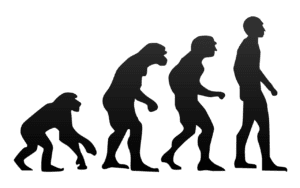Column: Time rules Darwin’s predictions inaccurate
September 16, 2019
Evolutionists admit that there are holes in evolutionary theory, but are confident that such holes will be filled in over time as more research is done on the matter. Time, however, resting comfortably on her distinguished bench, has ruled with the falls of her gavel that such predictions are inaccurate. How much longer must the judge Time sit for us to respect her rulings?
Vestigial structures, DNA
Vestigial structures and DNA are classic holes in evolutionary theory. But interestingly, rather than claiming that these holes will be filled in through Time, many evolutionists argue that they have already been filled in. Thus so-called vestigial structures and DNA are understood in most biology textbooks as indisputable evidence for evolution. This however is not the case. Time’s gavel has fallen often against this matter.
So what are vestigial structures? According to LiveScience, they are those structures of an organism that “We (and other species) no longer rely on…for any serious function, or they have atrophied or degenerated to the point that they don’t serve the function they used to.” In general, evolutionists believe that the allegedly unused or less used structures of an organism either existed with the same purpose at the higher function in one or more of an organism’s ancestor(s), or served a different function in one or more of an organism’s ancestor(s). Evolutionists claim that this supports their theory because for common ancestry to be true, there must be evidence. Parts of our genetics both seen by the naked eye and, as I will discuss later, by the microscope, must show signs of a previous ancestor.
There are many examples of ‘vestigial’ structures that evolutionists have bartered for over the years, but perhaps the most notable examples are that of the human appendix, the human tailbone, and ‘legs’ on snakes. These, along with nearly all so-called vestigial structures, have been ruled by Time and her spouse Discovery to serve a function. Ironically, according to the same LiveScience article, the human appendix has been found “as an important storehouse for beneficial bacteria.” It also hosts antibody-producing blood cells that are an integral part of the immune system. The human tailbone, otherwise known as the coccyx, according to Healthline, “serves as an attachment site for tendons, ligaments, and muscles. It also…(is) an insertion point of some of the muscles to the pelvic floor. The coccyx also functions to support and stabilize a person while he or she is in the sitting position.” The ‘legs’ of snakes act as stimulators during sexual activity. Furthermore, according to Sarah Chaffee for Evolution News, “biologist Steven Scadding argued that although he had no objection to Darwinism, “ .””
Evolutionists who have realized this will then argue that although the structures serve a function and have served the same function over the course of history, that they are somehow vestigial because the organism that they are a part of can survive and in most cases thrive without them. This claim is simply evolutionists twisting a word’s definition to support their view. Merriam-Webster Dictionary defines the word vestigial as “remaining in a form that is small or imperfectly developed and not able to function.” This was the original definition evolutionists used until it did not work in their favor. Moreover, this play on definitions is illogical. People can survive and in most cases thrive without their pinky fingers, and that does not make pinky fingers a vestigial structure.
Genetics did not fully become a component of evolutionary theory until after Darwin, but what is true on the physical level must be true on the genetic level. So likewise with the argument for vestigial structures, evolutionists argue for vestigial (or as it is more commonly known as for the sake of catchiness) “junk” DNA. Just like vestigial structures, vestigial DNA is claimed by evolutionists to be evidence for common ancestry; in this scenario embedded into the genetic code, rather than physical appearances.
Reviewing a book by Dr. Darrell Falk on the subject, Casey Luskin for Evolution News wrote that “Dr. Falk relies heavily upon the argument that introns (a type of DNA) are “gibberish” DNA that we share with other species at the same position, and this supposedly demonstrates common ancestry. The problem for the argument is that introns are not “gibberish,” but have important functions, such as regulating gene expression.” Also according to Luskin, an article by W. Wayt Gibbs for Scientific American ,“explains how “the introns within genes and the long stretches of intergenic DNA between genes … were immediately assumed to be evolutionary junk”…The article admits that “(t)hat assumption was too hasty” and quotes a molecular biologist explaining how this Darwinian-based dogma stifled research, calling the failure to recognize introns as functional possibly “one of the biggest mistakes in the history of molecular biology.””
Introns are not the only type of DNA that Dr. Falk argues for as junk. He also argues for pseudogenes, which according to a paper in Annual Review of Genetics by Evgeniy S. Balakirev and Francisco J. Ayala,”have been suitably investigated (to) often exhibit functional roles, such as gene expression, gene regulation, generation of genetic… diversity … Pseudogenes exhibit evolutionary conservation of gene sequence, reduced nucleotide variability, excess synonymous over non-synonymous nucleotide polymorphism, and other features that are expected in genes or DNA sequences that have functional roles.”
Dr. Falk is also not the only evolutionist to support the idea of junk DNA, and introns and pseudogenes are not the only used and debunked examples of such DNA. For the sake of Time, however, I will end there on the topic of vestigial DNA. Her gavel has already pounded too much on the head of this tenent of evolutionary theory.
The fossil record
Evolutionists have long claimed that the fossil record provides sound evidence for evolution. They claim that the record shows how the ancestors of species evolved into what we know them as today. But two main things, unsurprisingly found via Time and her spouse Discovery, contradict this element of evolutionary theory; a lack of transitional forms among fossils, and a pattern of DNA explosions cumulatively known as the Cambrian Explosion.
It was not until after publishing his book On the Origin of Species, that Darwin realized a detrimental flaw in his evidence for evolution concerning fossils.
There are transitional forms among fossils.
If Darwinian theory were true, the fossil record would show the intermediary stages of evolution. For example, a human-monkey hybrid. A handful of paleontologists have discovered what they believe to be transitional forms, but their discoveries have either been debunked or are simply too questionable. Regardless, though, there are not enough such findings to infallibly prove evolution. Considering the amount of species on this planet, would we not have found more alleged transitional forms in the fossil record than we have?
Desperate to cover his butt, Darwin claimed that intermediate fossils had not yet been found because of physical and human imperfections in the geological record. Because Time had not yet ruled on the matter. In Darwin’s day, this claim worked. But now it is but another lame attempt by evolutionists to twist fiction into fact. According to Luskin once more for Evolution News, “Paleontologists today generally recognize that while the fossil record is imperfect, it is still adequate to assess questions about evolution. One study in Nature (direct source no longer available) reported that “…the past 540 million years of the fossil record provide uniformly good documentation of the life of the past.”” The article then goes on to mention that “realization that the fossil record is not…incomplete has forced evolutionary biologists to accept that the record shows a pattern of explosions, not gradual evolution of living organisms.”
First of all, “…a pattern of explosions” is impossible under how Darwinism explains the origins of species. Evolution plays on the gradual, long process of mutations formed via natural selection. The explosions of life mentioned in the article (known wholly as the Cambrian Explosion as they occurred during the Cambrian period) took place either over seventy-million or ten million years, depending on who you talk to. Regardless, though, both proposals are but glimpses of time considering the Earth’s four and a half billion year history. Most evolutionists agree that evolution could not have happened over such a short period of time. Going off of that, the Cambrian Explosion was specifically when phyla (the major animal groups) appeared abruptly in the fossil records. But here is the key thing. The phyla were fully developed, and like I already said, appeared abruptly.
There is no phyla, nothing remotely related to phyla, or anything that could be the intermediary stages of an ancestor of a kind of phyla becoming that kind of phyla in the precambrian fossil records.
It was a total explosion. Evolution could therefore not have cultivated the life that the Cambrian period birthed, and Darwin knew this.
So he tried to cover his butt.
Darwin thus moved on to argue for physical imperfections in the fossil records. According to Jonathan Wells for Evolution News, “he (Darwin) argued that Precambrian fossils (namely phyla) had been destroyed by heat, pressure, and erosion. Some of Darwin’s modern followers have likewise argued that Precambrian fossils existed but were later destroyed, or that Precambrian organisms were too small or too soft to have fossilized in the first place.” However, “since 1859…paleontologists have discovered many Precambrian fossils, many of them microscopic or soft-bodied. As American paleobiologist William Schopf wrote… “The long-held notion that Precambrian organisms must have been too small or too delicate to have been preserved in geological materials… (is) now recognized as incorrect.”
To conclude, according to the same article, “the abrupt appearance of the major animal phyla about 540 million years ago…is better documented now than in Darwin’s time. According to Berkeley paleontologist James Valentine and his colleagues, the “explosion is real, it is too big to be masked by flaws in the fossil record.” Indeed, as more fossils are discovered it becomes clear that the Cambrian explosion was “even more abrupt and extensive than previously envisioned.”” Time has ruled once again.
This article has been updated for clarification.


















Floyd Green • May 21, 2021 at 6:31 pm
How accurate is this reporting?
I do believe God created all this. And humans directly as a set apart “species”.
As I read articles, papers, and “evidence” that evolutionists put out, I see a continual use of words like “generally accepted, likely, assumptions, suggests, may be, should, could….”
And to go along with all the “errors” such as primordial soup, and obvious holes, it appears that this isn’t science, it is a philosophy (I explain it as a cult of science).
I liken it to keeping the lie going, a lie they believe to be true.
My first question isn’t an accusation, but as I continue to research, with as much as an open mind as my supposed “indoctrination” allows, I know if I present this information, it will be ridiculed because of this being written by a high school. I don’t look down on the young. I have learned many profound things from our youth.
It does not appear to have been written by a most typical high schoolers. So if it was, that is a compliment.
Lisa Roskens • Jun 7, 2021 at 7:50 am
Thank you for your comment. This article is a “column,” with that said, it does not include “reporting,” but rather a gathering of materials to support the “opinion” of writer Kate Keeler. Again, thank you for reading and for commenting. We like to run the opinions of our readers, too.